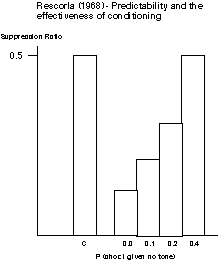|
The results of different timing procedures suggests that an important determinant of the success and strength of conditioning might be the extent to which the CS predicts the US. Is predictability important above and beyond the number of times the CS and US occur together? In order to examine whether predictability is important above and beyond the number of times the CS and US occur together, let's require a procedure in which the correlation between CS and US occurrence is varied while the total number of times the subjects are exposed CS-US pairings are held fixed. An experiment which examined this question was devised by Rescorla (1968). He took four groups of rats and exposed them all to tone-shock pairings. In each test session the animals heard a number of 2 minute tones interspersed by silences. For all groups the probability that they would experience a shock while hearing the tone was 0.4. The groups differed in the probability that they were also shocked during the silences occurring between tones - one group received no shocks during these intervals (a probability of 0.0), the other groups received shocks during the 'no tone' intervals with probabilities of 0.1, 0.2 and 0.4. So, although all the groups receive the same number of tone-shock pairings the tone becomes a progressively better predictor of shock as the probability of shock occurring during the 'no-tone' intervals decreases. He also tested a control group who received no shocks but heard the same number of tones as the experimental groups. The results clearly show that CS-US predictability is an important factor in determining the efficacy of conditioning - the more the experimental groups were shocked during no-tone intervals the less the tone could predict shock and the less their bar pressing was suppressed by the tone during the conditioned suppression test-phase of the experiment.
This experiment was the forerunner of many others which were used in attempts to discover precisely how animals use information available to them about stimuli to learn about their environment. Two other phenomena concerned with the way a CS can be used to predict the occurrence of a US form the building blocks for this work - overshadowing and blocking.
|
